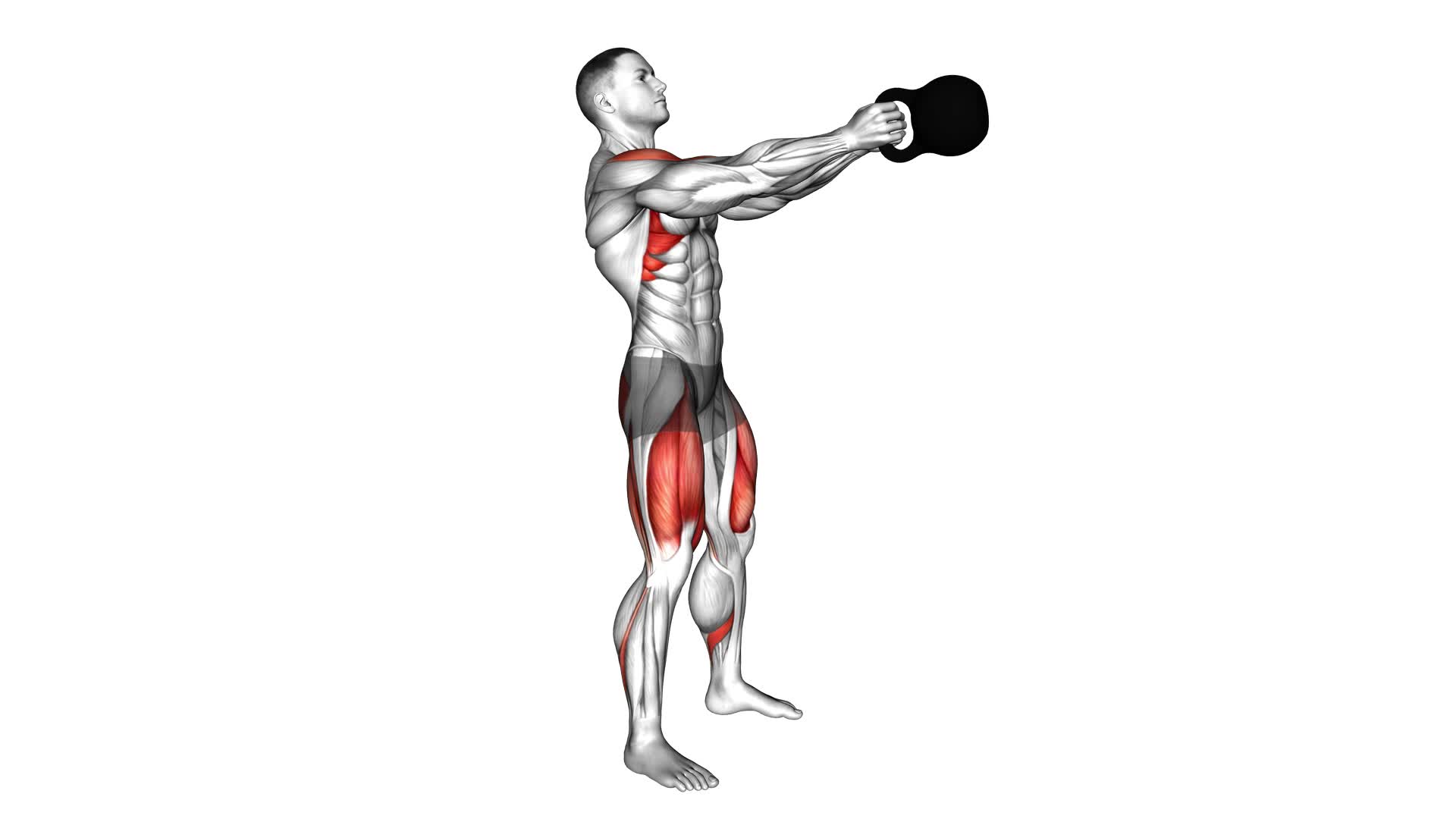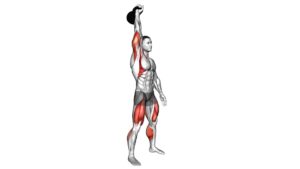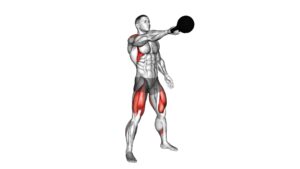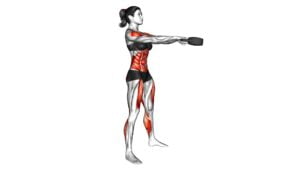Kettlebell Swing – Video Exercise Guide & Tips

Get ready to elevate your fitness routine with the kettlebell swing.
Watch This Exercise Video
In this video exercise guide, we'll show you the proper technique and form to maximize your results.
Avoid common mistakes and discover variations and progressions to challenge yourself.
With our expert tips, you'll be swinging like a pro in no time.
Grab a kettlebell and get ready to transform your body with this dynamic and effective workout.
Let's swing into action!
Key Takeaways
- Kettlebell swing improves cardiovascular fitness and activates multiple muscle groups simultaneously.
- Proper technique and form involve engaging core muscles, using power from hips and glutes, and maintaining a straight back.
- Common mistakes to avoid include using arms instead of hips and legs, neglecting to engage core muscles, and using a kettlebell that's too heavy.
- Variations and progressions of the kettlebell swing can increase difficulty and engage different muscle groups.
Benefits of Kettlebell Swing
Discover the numerous benefits of incorporating kettlebell swings into your workout routine. Kettlebell swings offer a wide range of health benefits and are known for their ability to activate multiple muscle groups simultaneously.
One of the key health benefits of kettlebell swings is improved cardiovascular fitness. This exercise requires a combination of strength and endurance, making it an excellent choice for improving your heart health. By incorporating kettlebell swings into your routine, you can increase your heart rate and improve your overall cardiovascular endurance.
In addition to cardiovascular benefits, kettlebell swings also activate a variety of muscle groups. This exercise primarily targets the glutes, hamstrings, and core muscles. By swinging the kettlebell between your legs and thrusting it forward, you engage these muscles and build strength and power.
Furthermore, kettlebell swings can help improve your posture and balance. The explosive movement of swinging the kettlebell requires proper form and technique, which in turn strengthens your back and improves your overall posture. Additionally, the engagement of your core muscles helps to stabilize your body, leading to improved balance.
In summary, incorporating kettlebell swings into your workout routine can provide numerous health benefits, including improved cardiovascular fitness, increased muscle activation, and enhanced posture and balance.
Proper Technique and Form
To perform the kettlebell swing with proper technique and form, you should focus on engaging your core muscles and maintaining a stable posture.
One of the common misconceptions about the kettlebell swing is that it's primarily an arm exercise. In reality, the power for the movement comes from the hips and glutes.
As you swing the kettlebell forward, you want to hinge at the hips and drive them forward explosively, using the power generated from your lower body to propel the kettlebell.
It's important to keep your back straight throughout the movement and avoid rounding your shoulders.
Additionally, to prevent injury, make sure to use a weight that you can handle comfortably and gradually increase the weight as you become stronger and more proficient in the exercise.
Remember to warm up properly before starting, and if you experience any pain or discomfort, stop immediately and seek guidance from a fitness professional.
Common Mistakes to Avoid
To prevent injury and maximize the effectiveness of your kettlebell swing, it's important to be aware of common mistakes to avoid. Injury prevention should be your top priority when performing this exercise.
One common misconception is using your arms to lift the kettlebell, instead of using your hips and legs to generate the power. This puts unnecessary strain on your shoulders and can lead to injury.
Another mistake isn't maintaining a neutral spine throughout the movement. Arching your back or rounding your shoulders can put excessive pressure on your spine and increase the risk of back pain.
Additionally, avoid using a kettlebell that's too heavy for your current strength level. This can cause improper form and increase the likelihood of straining your muscles or joints.
Lastly, remember to engage your core muscles throughout the exercise. Neglecting to do so can lead to lower back pain and instability.
Variations and Progressions
Try incorporating variations and progressions into your kettlebell swing routine to challenge yourself and continue progressing in your fitness journey.
By adding advanced variations and kettlebell swing progressions, you can take your workout to the next level and target different muscle groups.
One advanced variation is the single-arm kettlebell swing, which requires more core stability and shoulder strength. Instead of using both hands to grip the kettlebell, hold it with one hand and perform the swing motion.
Another variation is the double kettlebell swing, where you use two kettlebells instead of one. This increases the load on your muscles and challenges your grip strength.
To progress further, you can try incorporating explosive movements like the kettlebell swing clean and press. This exercise combines the power of the swing with an overhead press, engaging your shoulders and upper body even more.
Remember to always start with proper form and gradually increase the difficulty level as you become more comfortable and strong.
Keep challenging yourself with these advanced variations and progressions to continually improve your kettlebell swing routine.
Tips for Maximizing Results
To maximize your results with the kettlebell swing, focus on maintaining proper form and gradually increasing the weight and intensity of your swings. Proper form is crucial for targeting the right muscles and preventing injuries. Make sure to keep your back straight, engage your core, and use your hips to generate the power for the swing.
As you become more comfortable with the exercise, you can start increasing the weight of the kettlebell. This will challenge your muscles even more and help you build strength and endurance.
Incorporating the kettlebell swing into a full body workout is another great way to maximize your results. This exercise engages multiple muscle groups, including your legs, glutes, core, and shoulders. You can combine it with other exercises like squats, lunges, and push-ups to create a well-rounded workout that targets your entire body.
To increase the intensity of your kettlebell swing, you can try different variations. For example, you can perform single-arm swings or double kettlebell swings. These variations require more stability and strength, and they can help you take your workout to the next level.
Frequently Asked Questions
How Many Calories Can You Burn With a Kettlebell Swing?
You can burn a significant amount of calories with kettlebell swings. This exercise is a great way to get your heart rate up and increase your overall calorie burn.
Not only does it target your muscles, but it also engages your core and provides cardiovascular benefits.
Can Kettlebell Swings Help With Weight Loss?
Kettlebell swings can definitely help with weight loss. By incorporating this exercise into your fitness routine, you can burn a significant amount of calories and improve your overall cardiovascular fitness.
Not only that, but kettlebell swings also provide muscle toning benefits, particularly for your glutes, hamstrings, and core.
Are Kettlebell Swings Suitable for Beginners?
Kettlebell swings are a great exercise for beginners. They offer numerous benefits for those just starting out. They can help improve strength, build endurance, and increase cardiovascular fitness.
However, it's important to learn the proper form to avoid common mistakes. Engaging your core, using your hips to generate power, and maintaining a neutral spine are key.
With practice and guidance, kettlebell swings can be a valuable addition to any beginner's fitness routine.
Can Kettlebell Swings Help Improve Athletic Performance?
Kettlebell swings can definitely help improve your athletic performance. By incorporating kettlebell swings into your training routine, you can experience improvements in agility, power, and explosiveness.
Athletes can benefit greatly from the swinging motion of kettlebell exercises, as it engages multiple muscle groups and enhances overall strength.
The dynamic nature of kettlebell swings challenges your body in a unique way, allowing you to develop functional strength that translates to better performance in sports and other physical activities.
How Often Should Kettlebell Swings Be Performed for Optimal Results?
To achieve optimal results with kettlebell swings, it's important to consider the frequency of your workouts. By incorporating kettlebell swings into your routine on a regular basis, you can maximize the benefits.
The frequency will depend on your fitness level and goals. However, a general guideline is to perform kettlebell swings two to three times per week. This allows your muscles time to recover and adapt, leading to improved athletic performance over time.
Conclusion
In conclusion, the kettlebell swing is a highly effective exercise that offers numerous benefits, including improved strength, cardiovascular fitness, and fat loss.
By mastering proper technique and form, avoiding common mistakes, and exploring variations and progressions, you can maximize your results.
Remember to stay consistent and gradually increase the intensity to continue challenging your body and achieving your fitness goals.
So grab a kettlebell and start swinging your way to a stronger, fitter you!

Author
Years ago, the spark of my life’s passion ignited in my mind the moment I stepped into the local gym for the first time. The inaugural bead of perspiration, the initial endeavor, the very first surge of endorphins, and a sense of pride that washed over me post-workout marked the beginning of my deep-seated interest in strength sports, fitness, and sports nutrition. This very curiosity blossomed rapidly into a profound fascination, propelling me to earn a Master’s degree in Physical Education from the Academy of Physical Education in Krakow, followed by a Sports Manager diploma from the Jagiellonian University. My journey of growth led me to gain more specialized qualifications, such as being a certified personal trainer with a focus on sports dietetics, a lifeguard, and an instructor for wellness and corrective gymnastics. Theoretical knowledge paired seamlessly with practical experience, reinforcing my belief that the transformation of individuals under my guidance was also a reflection of my personal growth. This belief holds true even today. Each day, I strive to push the boundaries and explore new realms. These realms gently elevate me to greater heights. The unique combination of passion for my field and the continuous quest for growth fuels my drive to break new ground.







